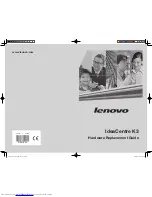
About the Script Commands
41
create-virtual-disk-copy-attr-value-list
create-virtual-disk-copy-attr-value-pair
{
create-virtual-disk-copy-attr-value-pair
}
create-virtual-disk-copy-attr-value-pair
copyPriority=highest | high | medium |
low | lowest |
targetReadOnlyEnabled=boolean
recover-raid-virtual-disk-attr-value-list
recover-raid-virtual-disk-attr-value-pair
{
recover-raid-virtual-disk-attr-value-pair
}
recover-raid-virtual-disk-attr-value-pair
owner=(0 | 1)
Table 2-5. Range of Values for Recurring Syntax Elements
Recurring Syntax
Syntax Values
IPV4Priority
0 to 7
IPV4VlanID
1 to 4094
IPV6Priority
0 to 7
IPV6VlanID
1 to 4094
IPV6HopLimit
0 to 255 (default value is 64)
IPV6NdDetectDuplicateAddress
0 to 256
IPV6NdReachableTime
0 to 65535 (default value is
30000 milliseconds)
IPV6RetransmitTime
0 to 65535 (default value is
1000 milliseconds)
IPV6NDTimeOut
0 to 65535 (default value is
3000 milliseconds)
Table 2-4. Recurring Syntax Elements
(continued)
Recurring Syntax
Syntax Value
book.book Page 41 Wednesday, June 8, 2011 12:20 PM
Summary of Contents for PowerVault MD3600f Series
Page 1: ...Dell PowerVault Modular Disk Storage Arrays CLI Guide ...
Page 44: ...44 About the Script Commands ...
Page 114: ...114 Using the Remote Replication Premium Feature ...
Page 311: ...Script Commands 311 ...
Page 312: ...312 Script Commands ...
Page 318: ...318 Sample Script Files ...
Page 328: ...Index 328 ...
















































